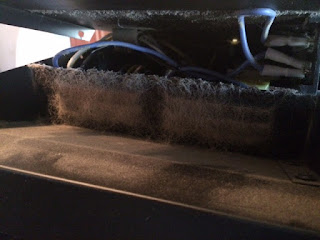See RV toilets are usually operated by a foot pedal (spelled it right for once), pressing down part way starts water flowing into the bowl. Pressing all the way down opens the "flapper or ball" letting the waste drop/flow to the black holding tank. The small important part that failed was the plastic shaft that connects the flapper to the foot pedal, meaning the only way to open and close the flapper was by hand. And I do mean by HAND.
Knowing that this situation would not work for either of us for our overnight trips to the Loo. I took the entire pedal flapper assembly apart and looked at how I could use duct tape and bailing wire to fix this problem until morning. Seeing that all the parts are plastic and are either covered in grease or poo, glue or tape was not an option. Tried to screw pieces together, no go. By now it's getting late and a line started to form outside. I needed a quick band-aid fix now!
My solution was easy but very smelly; leave the flapper open and manual rinse with water. Problem with this solution was all the wonderful smells from the black tank will waft into the bathroom then into the rest of the coach. But if I could easily seal the toilet from our living space it could work! What to use as a seal? Trash bag? Nope, too much trouble to place/remove over entire toilet and lacked a airtight seal. Stretch wrap! Of course, what is a toilet but just a large porcelain bowl. Problem is we have stretch wrap but is not wide enough to cover the bowl with one piece. Two pieces don't seal as well and repeated use may be a problem. I need something quick, I'm starting to taste the smell!
It then came to me, from my daily experience washing dishes the solution was right next to the stretch wrap; ziplock bags! Yes, a ziplock bag. Rana and I reuse many of these bags by washing them in hot soapy water and as they sit in the sink to be rinsed they tend to block water from going down the drain. So why not fill a gallon size bag with water to plug the flapper hole in the toilet. Success!!
The bag covered the hole without a chance of falling through and was easily removed and placed in the shower pan when you had to go. The rinse part of the foot pedal still worked so the bowl was always clean and wet prior to placing bag back.
 This solution worked for about two days until the new toilet arrived (replacement parts are not available for this toilet) so I consider it a complete success. It was at this point I decided to add a shutoff valve at the toilet so periodic maintenance could be done without having to shutoff water to the entire coach. This portion of the project would have been a slam-dunk however the powers that be (Dometic, the toilet manufacturer) decided that using the standard plumbing connection would be too simple. Nooooo, lets use something different to make every RVer's life more exciting.
This solution worked for about two days until the new toilet arrived (replacement parts are not available for this toilet) so I consider it a complete success. It was at this point I decided to add a shutoff valve at the toilet so periodic maintenance could be done without having to shutoff water to the entire coach. This portion of the project would have been a slam-dunk however the powers that be (Dometic, the toilet manufacturer) decided that using the standard plumbing connection would be too simple. Nooooo, lets use something different to make every RVer's life more exciting.The threaded connection on the back of the toilet is the same as the threaded connection for faucets. So when you choose to upgrade and add a shutoff valve remember to get a faucet supply line and not a toilet supply line. Other than that life is good.


